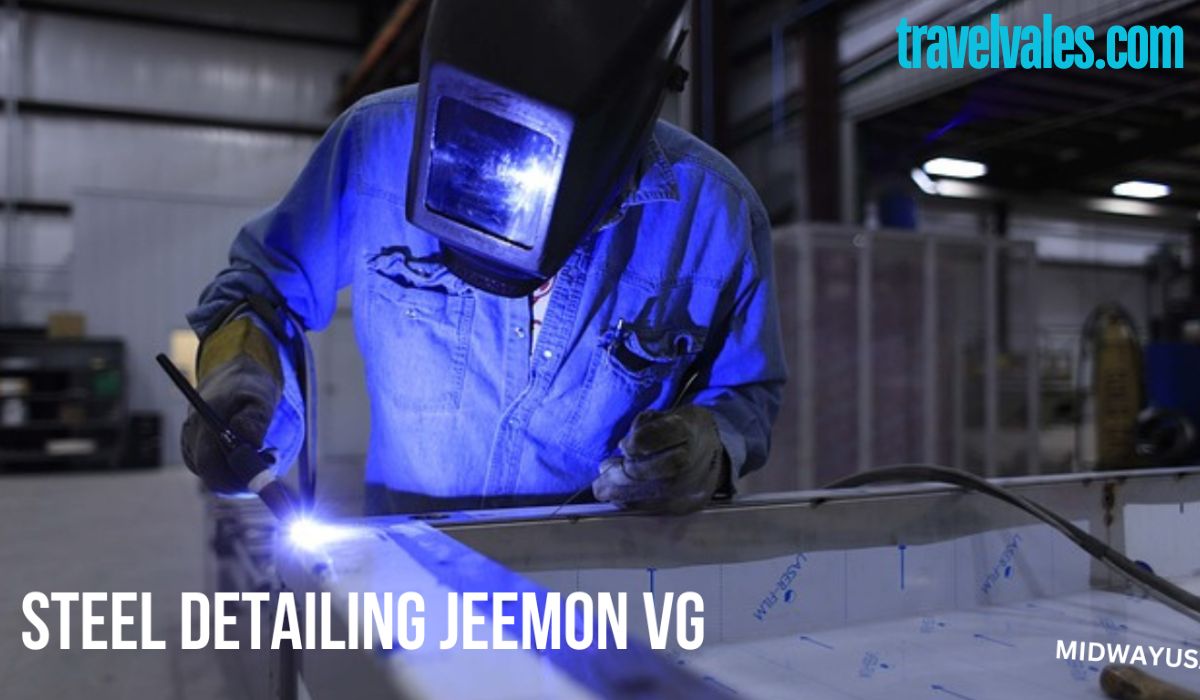Introduction to Steel Detailing Jeemon VG
Steel detailing Jeemon VG is a crucial process in the construction and engineering industry. It involves creating detailed drawings and plans for steel structures, ensuring that every component fits perfectly during assembly. The precision and accuracy required in steel detailing make it a specialized field that demands expertise and experience.
What is Steel Detailing?
Steel detailing is the production of detailed drawings for steel fabricators and erectors. These drawings cover every individual steel piece and provide the necessary specifications for manufacturing and erection. The process includes:
- Shop Drawings: Detailed drawings for the fabrication of steel components.
- Erection Drawings: Plans showing the location and positioning of steel components during assembly.
Importance of Steel Detailing
Steel detailing ensures that:
- Structures are safe and comply with all building codes and regulations.
- The construction process is efficient, minimizing errors and rework.
- Costs are controlled through accurate material estimation and planning.
Who is Jeemon VG?
Jeemon VG is a renowned name in the field of steel detailing. With years of experience and numerous successful projects, Jeemon VG has established himself as an expert in this specialized field. His work is known for its precision, quality, and adherence to industry standards.
Jeemon VG’s Background
Jeemon VG holds a degree in civil engineering and has over 15 years of experience in steel detailing. His expertise spans across various sectors, including commercial, industrial, and residential projects. Jeemon VG’s commitment to excellence has earned him a reputation as one of the best in the industry.
The Process of Steel Detailing
Steel detailing is a meticulous process that involves several stages, each crucial for the final outcome. Let’s delve into each stage to understand the complexity and importance of this process.
1. Understanding the Project Requirements
The first step in steel detailing is to thoroughly understand the project requirements. This involves:
- Reviewing architectural and engineering drawings.
- Understanding the specifications and standards.
- Identifying potential challenges and constraints.
2. Creating the Initial Drafts
Once the requirements are clear, the next step is to create initial drafts. These drafts serve as the foundation for the detailed drawings and include:
- Preliminary layouts of the steel structure.
- Basic dimensions and specifications.
- Initial material estimates.
3. Detailed Drawing Preparation
The heart of steel detailing is the preparation of detailed drawings. This stage involves:
- Creating shop drawings for every steel component.
- Preparing erection drawings showing the placement and assembly of components.
- Including all necessary details such as dimensions, materials, and welding specifications.
4. Review and Quality Assurance
Before finalizing the drawings, they undergo a rigorous review and quality assurance process. This ensures that:
- All drawings are accurate and comply with industry standards.
- Potential errors and inconsistencies are identified and corrected.
- The final drawings are ready for fabrication and erection.
5. Collaboration with Fabricators and Erectors
Effective collaboration with fabricators and erectors is essential for the success of a steel detailing project. This involves:
- Providing clear and detailed instructions.
- Addressing any queries or concerns promptly.
- Ensuring smooth communication throughout the project.
Tools and Software Used in Steel Detailing
The advancements in technology have revolutionized the field of steel detailing. Today, several specialized tools and software are used to enhance the accuracy and efficiency of the process.
Popular Software in Steel Detailing
Some of the most widely used software in steel detailing include:
- AutoCAD: A versatile tool for creating detailed 2D and 3D drawings.
- Tekla Structures: A powerful BIM software for creating accurate and detailed 3D models.
- Revit: Another BIM software widely used for its robust modeling capabilities.
Advantages of Using Specialized Software
Using specialized software offers several advantages, such as:
- Increased Accuracy: Advanced tools help in creating precise and error-free drawings.
- Enhanced Collaboration: Cloud-based platforms enable seamless collaboration among team members.
- Time Efficiency: Automation of repetitive tasks speeds up the detailing process.
Key Elements of a Steel Detailing Project
A successful steel detailing project hinges on several key elements. Understanding these elements helps in appreciating the complexity and importance of the process.
1. Accuracy and Precision
Accuracy and precision are the cornerstones of steel detailing. Even the smallest error can lead to significant issues during fabrication and erection. Therefore, every dimension and specification must be meticulously checked and verified.
2. Compliance with Standards
Compliance with industry standards and regulations is non-negotiable in steel detailing. This ensures that the structure is safe, durable, and fit for purpose. Common standards include:
- AISC (American Institute of Steel Construction): Provides guidelines for steel construction in the United States.
- BS (British Standards): Used in the UK and other countries following British regulations.
- Eurocodes: A set of European standards for construction.
3. Effective Communication
Effective communication among all stakeholders is crucial for the success of a steel detailing project. This includes:
- Regular updates and progress reports.
- Prompt resolution of queries and issues.
- Clear and concise documentation.
4. Attention to Detail
Attention to detail is what sets apart a good steel detailing project from a great one. Every aspect, from the choice of materials to the placement of bolts, must be carefully considered and documented.
Challenges in Steel Detailing
Steel detailing is not without its challenges. Understanding these challenges helps in better preparing for and mitigating them.
Common Challenges Faced
Some common challenges in steel detailing include:
- Complex Designs: Modern architectural designs can be complex, requiring advanced detailing techniques.
- Tight Deadlines: Meeting project deadlines while ensuring accuracy can be demanding.
- Coordination Issues: Ensuring seamless coordination among various stakeholders can be challenging.
Overcoming the Challenges
Overcoming these challenges requires:
- Experience and Expertise: Experienced detailers like Jeemon VG bring invaluable expertise to the table.
- Advanced Tools: Using the latest software and tools enhances efficiency and accuracy.
- Proactive Communication: Regular and proactive communication helps in addressing issues promptly.
Case Studies of Jeemon VG’s Projects
Examining some of Jeemon VG’s notable projects provides insight into his expertise and approach to steel detailing.
Project 1: High-Rise Office Building
In this project, Jeemon VG was responsible for detailing a high-rise office building. Key highlights include:
- Complex Structure: The building had a unique design with complex structural elements.
- Precision Detailing: Detailed drawings ensured that every component fit perfectly during assembly.
- Successful Execution: The project was completed on time and within budget, with no major issues during erection.
Project 2: Industrial Warehouse
This project involved detailing an industrial warehouse. Key highlights include:
- Large-Scale Project: The warehouse spanned a vast area, requiring meticulous planning and detailing.
- Advanced Software: Using advanced BIM software helped in creating accurate 3D models.
- Efficient Collaboration: Effective communication with fabricators and erectors ensured smooth execution.
Project 3: Residential Complex
In this project, Jeemon VG detailed a residential complex with multiple buildings. Key highlights include:
- Diverse Requirements: Each building had unique requirements, demanding a tailored approach.
- Attention to Detail: Every aspect, from materials to assembly, was meticulously detailed.
- High Satisfaction: The project was completed to the client’s satisfaction, with no major issues reported.
Future Trends in Steel Detailing
The field of steel detailing is continuously evolving, with new trends and technologies shaping its future.
1. Integration with BIM
Building Information Modeling (BIM) is revolutionizing the construction industry, and steel detailing is no exception. The integration of BIM allows for:
- Enhanced Collaboration: BIM facilitates seamless collaboration among all stakeholders.
- Improved Accuracy: 3D models help in identifying and resolving issues early in the process.
- Efficient Planning: BIM aids in better project planning and resource management.
2. Automation and AI
Automation and artificial intelligence (AI) are set to transform steel detailing. Key benefits include:
- Speed: Automation of repetitive tasks speeds up the detailing process.
- Consistency: AI ensures consistent quality and accuracy in drawings.
- Innovation: AI-driven tools can provide innovative solutions to complex problems.
3. Sustainability
Sustainability is becoming increasingly important in the construction industry. Steel detailing is contributing to this trend through:
- Efficient Material Use: Accurate detailing minimizes material wastage.
- Green Building Standards: Compliance with green building standards promotes sustainability.
- Innovative Materials: The use of innovative, eco-friendly materials is on the rise.
YOU MAY ALSO LIKE: Understanding Çeviit: A Comprehensive Guide
Conclusion
Steel detailing is a critical process in the construction and engineering industry, demanding precision, expertise, and meticulous planning. Jeemon VG stands out as a leader in this field, known for his exceptional skills and successful projects. By leveraging advanced tools and technologies, maintaining strict adherence to standards, and fostering effective communication, Jeemon VG continues to set the benchmark in steel detailing.
Understanding the intricacies of steel detailing, the challenges faced, and the future trends helps in appreciating the importance and complexity of this field. As the industry evolves, professionals like Jeemon VG will continue to play a pivotal role in shaping the future of steel construction.
Key Takeaways
- Steel detailing involves creating detailed drawings and plans for steel structures.
- Jeemon VG is a renowned expert in the field with extensive experience.
- Key elements of a successful project include accuracy, compliance, and effective communication.
- Challenges in steel detailing can be mitigated through experience, advanced tools, and proactive communication.
- Future trends include the integration of BIM, automation,
FAQS
1. What is steel detailing and why is it important?
Steel detailing is the process of creating detailed drawings and plans for steel structures, including individual components and their assembly. It is crucial because it ensures:
- Accuracy: Every steel component is precisely fabricated and assembled.
- Safety: Structures meet all safety standards and regulations.
- Efficiency: Reduces errors, material wastage, and rework, saving time and costs.
- Coordination: Facilitates smooth communication among architects, engineers, fabricators, and erectors.
2. Who is Jeemon VG and what is his expertise in steel detailing?
Jeemon VG is a highly experienced professional in the field of steel detailing, with over 15 years of experience. He holds a degree in civil engineering and has worked on numerous successful projects across various sectors, including commercial, industrial, and residential. Jeemon VG is known for his precision, quality, and adherence to industry standards in steel detailing.
3. What tools and software are commonly used in steel detailing?
Common tools and software used in steel detailing include:
- AutoCAD: For creating detailed 2D and 3D drawings.
- Tekla Structures: A BIM software for accurate and detailed 3D modeling.
- Revit: Another BIM software with robust modeling capabilities.
These tools enhance accuracy, facilitate collaboration, and improve efficiency in the detailing process.
4. What are the key elements to consider in a steel detailing project?
Key elements to consider in a steel detailing project are:
- Accuracy and Precision: Ensuring every dimension and specification is correct.
- Compliance with Standards: Adhering to industry standards and regulations for safety and durability.
- Effective Communication: Maintaining clear and concise communication among all stakeholders.
- Attention to Detail: Considering every aspect of the project, from material choice to bolt placement.
5. What are the future trends in steel detailing?
Future trends in steel detailing include:
- Integration with BIM: Enhancing collaboration, accuracy, and project planning through Building Information Modeling.
- Automation and AI: Speeding up processes and ensuring consistent quality with automation and artificial intelligence.
- Sustainability: Promoting efficient material use, compliance with green building standards, and innovative eco-friendly materials.
Understanding these trends helps professionals stay ahead in the evolving field of steel detailing.








